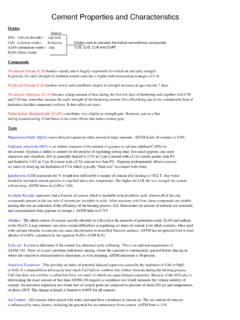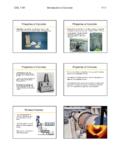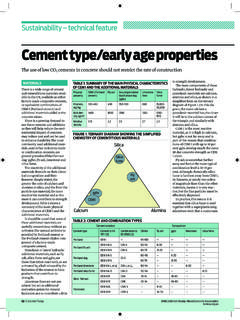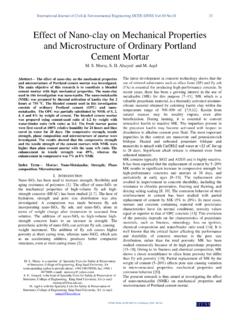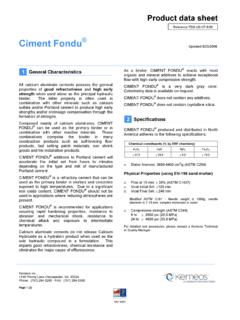Transcription of EFFECT ON SLAG HYDRATION OF BLAST-FURNACE SLAG …
1 EFFECT ON SLAG HYDRATION OF BLAST-FURNACE SLAG cement IN DIFFERENT CURING CONDITIONS 1 Takeshi IYODA* 1 Department of Civil Engineering, Shibaura Institute of Technology, Tokyo, Japan 2 Kimihiro INOKUCHI 2 Department of Civil Engineering, Shibaura Institute of Technology, Tokyo, Japan 3 Taketo UOMOTO 3 Public Works Research Institute, Ibaraki, Japan Abstract In Japan, the usage of blast furnace slag in construction will increase due to environmental considerations. However, the EFFECT of curing condition and curing period on the HYDRATION of cement and slag HYDRATION in blended cements is not clear, nor is the relative contribution of cement and slag HYDRATION to strength and durability development in blended cement . In this research, the cement and slag HYDRATION ratio in BLAST-FURNACE slag cement under different curing conditions, such as temperature, relative humidity, and curing period, is measured using the selective dissolution method.
2 It was found that HYDRATION stops if relative humidity is less than 80%, and that if 80% relative humidity is maintained HYDRATION can occur even at temperatures as low as 7 degrees Celsius. On the other hand, the speed of HYDRATION is faster at higher temperatures such as 40 degrees Celsius than at normal temperatures such as 20 degrees Celsius, so it can be concluded that the influence of temperature on BLAST-FURNACE slag in BLAST-FURNACE slag cement is similar to that of temperature on ordinary Portland cement . The HYDRATION of BLAST-FURNACE slag is also influenced by mix proportions such as water- cement ratio and Blaine s fineness of cement . In the case of high water- cement ratio, the HYDRATION ratio of slag will increase and reach a high HYDRATION ratio; however, in the case of low water- cement ratio the HYDRATION of slag will stop at a low HYDRATION ratio at an early age.
3 Using these results showing the HYDRATION ratio of slag with different mix proportions and curing conditions, estimation of the HYDRATION of BLAST-FURNACE slag cement under different conditions may be performed. Originality Until now, measurement of the HYDRATION ratio of BLAST-FURNACE slag in BLAST-FURNACE slag cement has been performed under sealed condition which represents the ideal case in order to clearly show the slag HYDRATION . However, these conditions are not reflective of the actual conditions of concrete structures, so it is important to estimate the HYDRATION ratio of BLAST-FURNACE slag under real conditions considering both varying temperatures and relative humidity. It is also necessary to consider the EFFECT of HYDRATION ratio at varying mix proportions and different types of blast furnace slag. Chief contributions Concrete structure is exposed to various environment such as drying condition, high relative humidity and different temperatures.
4 And also internal condition in concrete structure is influenced high temperature by the heat of cement HYDRATION . Estimation of the HYDRATION of BLAST-FURNACE slag in BLAST-FURNACE slag cement on different condition is necessary for estimating the properties and durability of concrete structures. Currently, it is possible to estimate durability properties such as drying and autogeneous shrinkage, strength for concrete structures using ordinary Portland cement from HYDRATION of cement on mix proportions, but it is difficult to apply the same methods when using BLAST-FURNACE slag cement , because it is different of cement HYDRATION and slag reaction. This research may contribute to increasing the usage of BLAST-FURNACE slag in construction and thus helping to protect the global environment. Keywords: BLAST-FURNACE slag cement , slag reaction, selective dissolution, curing temperature, curing relative humidity *Coresponding author: E-mail- Tel- +81-5859-8356, Fax- +81-5859-8401 1.
5 Introduction In recent years, the usage of BLAST-FURNACE slag cement for concrete structures has increased in order to reduce carbon dioxide emissions and for improving durability. When compared to OPC, such blended cement produces smaller diameter pores due to the cement HYDRATION products, and controlling the cement HYDRATION is very important to ensure the concrete structure s durability and strength. However, the mechanism of HYDRATION or reaction in BLAST-FURNACE slag cement is not clear particularly the reaction of slag in blended cement so it is necessary to clarify this mechanism. In addition, curing is very important to achieve adequate binder HYDRATION . Construction is generally conducted outdoors, where curing conditions and environmental conditions have a large influence, so it is also necessary to consider the effects of temperature and humidity on the HYDRATION mechanism. This research investigated the influence of curing temperature, mix proportion, and slag replacement ratio on the slag reaction in BLAST-FURNACE slag cement under sealed conditions during Steps 1 and 2.
6 In Step 3 of this research, the EFFECT of curing conditions on cement HYDRATION under various temperatures and humidity conditions was investigated and compared between OPC and BLAST-FURNACE slag cement . 2. Experimental Outline Material Ordinary Portland cement (OPC) and Ground Granulated BLAST-FURNACE slag (GGBFS) were used in this research. Table-1 shows the mineral components of these materials. Table-1 Chemical components of the experimental materials Gravit yBlaine(g/cm3) (cm2/g) iO2 MnOSO3Na2OK2OP2O5 ClOP Component s (%) Samples In Steps 1 and 2 the cement paste sample was made using 30 milliliter glass bins, and sealed curing conditions, such as not demolded, were set for the total experimental age. Specimens were prepared in the laboratory at 20 degree Celsius. After preparation samples were capped immediately and exposed to each water curing environment, in which the water temperature was adjusted.
7 In Step 3, the sample size was 20 30 10 millimeters in order to maintain uniform humidity in each sample, and the samples were exposed to each relative humidity condition for the total experimental total. Samples were prepared in the laboratory at 20 degree Celsius and demolded after 24 hours, then exposed to various curing conditions. However, samples were dried in the atmosphere for 2 to 3 hours before exposure to each curing condition in order to avoid changing the humidity setting due to water evaporation from the samples. The set curing condition parameters were the temperature and humidity. Parameters Factors affecting the HYDRATION or slag reaction were varied, focusing particularly on material component such as slag replacement at different temperatures, water-binder ratios and curing conditions. Tables 2 to 4 show the parameters of this research. The samples used were cement paste.
8 Steps 1 and 2 targeted the measurement of the HYDRATION ratio of cement and GGBFS under sealed, or ideal, conditions. Step 3 focused on the measurement of the HYDRATION ratio of cement and GGBFS under environmental conditions. Step 1 (Table-2) focused on the EFFECT of curing temperature and GGBFS replacement on the reaction ratio. The water-binder ratio was constant at 50%, and curing temperatures were 5 degrees Celsius for winter conditions, 20 degrees Celsius for normal conditions, and 30, 40, and 60 degrees Celsius for summer conditions. The slag replacement ratio was 0% (OPC), 20% ( BLAST-FURNACE slag cement type BA), 42% (BB) and 67% (BC). Step 2 (Table 3) focused on the EFFECT of mix proportion and slag replacement ratio on the reaction ratio under normal curing temperatures at 20 degree Celsius. Three water binder ratios were set: 30%, 50%, and 60%; and there were three GGBFS replacement ratios: 0%, 20/30%, 50%, and 70%.
9 Step 3 (Table 4) focused on the EFFECT of relative humidity and temperature on the reaction ratio. The water binder ratio was 50% and slag replacement was 50%. The curing temperature was , 20 and 40 degrees Celsius, and four curing relative humidity values were selected: 40%, 60%, 80% and sealed conditions. Humidity was controlled by sodium hydroxide in order to preventing changes to the pore distribution and cement HYDRATION due to carbonation. The humidity control error was 3%. Table-2 Parameters of Step 1 (curing temperature) NBABBBC0%20%42%67%5 20 30 40 60 Temperaturecondition C Replacement (%) Table-3 Parameters of Step 2 (mix proportion) NBBBC0%20%30%50%70%L 30%)L0 L30L50L70M 50% M0M20 M50M70H 60% H0 H30H50H70 ReplacementBAW/B Table-4 Parameters of Step 3 (curing conditions) 40%60%80% C 20 C 40 C Humidity Methods for experiment The HYDRATION ratio and HYDRATION products were measured using the following method.
10 (1) Sample preparation The gathered samples were crushed at the testing age and soaked in acetone for 24 hours to stop HYDRATION . For Steps 1 and 2, the testing ages were 1, 3, 7, 28, 56 and 91 days; for Step 3, the testing ages were 1, 3, 7 and 28 days. (2) cement HYDRATION The cement HYDRATION was measured by ignition loss weight at 700 degree Celsius, which includes evaporation of free and chemically-bound water for HYDRATION with cement and GGBFS. Oxidized slag is also protected in high temperature environments, which is why 700 degree Celsius was selected. (3) Reaction ratio of BLAST-FURNACE slag The reaction ratio was measured by the selective dissolution method using salicylate acid acetone methanol solution. It is possible to measure the quantities of an-hydrated BLAST-FURNACE slag in this method. The grained sample ( ) was mixed with salicylate acid ( ), acetone (35ml) and methanol (15ml) for 1 hour, then allowed to sit for 23 hours.
